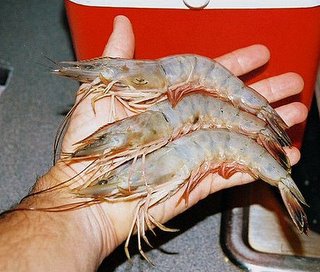

(photo: wild shrimp from St. Augustine, FL.)
You may eat shrimp in their headless, gutless, leggless , fried, boiled, sauteed, blackened, gumboed, creoled, grilled, baked, or steamed state, and yet never give much thought to the amazing little animal you are chewing.
First of all, they are Arthropods and as such, they own the planet. If you were an alien biologist who had just surveyed planet Earth for life forms, you would report back to your superiors that this is an Arthropod planet. Over 85% of all animal species belong in this incredibly successful phylum.
As an arthropod, shrimp share the basic Arthy characteristics of jointed appendages, an exoskeleton, and a segmented body. Insects ,Arachnids, and Crustaceans form the bulk of this group. Shrimp are crustaceans like their cousins the crab and lobster.
If you look at the shrimp in the picture above, you can see the first Arthropod characteristic, jointed appendages. The bottom shrimp probably shows this best...(note to self, take really close up picture before eating delicious photo subjects).
If you start at the "head" (which is not just a head), the antennae are jointed appendages used by the shrimp for sensing (smelling, tasting) his environment as well as a sense of balance. The shrimp's compound eyes are on stalks for near 360 degree vision. Pretty important when you are small and tastey.
There are some short appendages for food handling just under the shrimp's face. These aren't really showing well in this photo.
Beneath the "head" are 5 pairs of walking legs. These are used for...walking. Shrimp are in the order Decapoda (ten legs) because of this feature. So are the crabs and lobsters...if you're eating either right now and counting, the claws (called chelipeds) are just specialized legs so count them too.
Beneath the "tail" (abdomen) are the swimmerets. These are used for ...swimming, but only at cruising speed. Rapid backwards escape swimming is done by curving the body rapidly and flicking the tail.
Lady shrimp are ovigerous, that is, they carry their eggs under the abdomen attached to those swimmerets. When the eggs are ready, they hatch into planktonic larval shrimp and go through a series of changes on their way to your table.
The other characteristic easily seen is the segmented body.
The "head" or cephalothorax is really where most of the shrimp's organs are located. The abdomen is mostly muscle with intestine running through it.
If you have ever prepared fresh whole shrimp, you probably "deveined" them. Hopefully. That dark "vein" is the shrimp intestine and the stuff inside is shrimpoo.
The last major characteristic is the outer covering known as an exoskeleton. That's what you peel when you order "peel and eat" steamed shrimp. It's the "shell" on the crab or lobster. Shrimp have less armor than crabs and lobster since they are active swimmers.
The exoskeleton is made of a substance called "chitin" and is great protection, but it does have at least one flaw...it doesn't grow, so shrimp must molt to grow. Each time they molt (shed) their exoskeleton they have a few hours to stretch the new, still soft exoskeleton to a larger size before it hardens.
I hope something here was new, or at least an interesting review. The tastey little crescents on your plate really are fascinating when they are alive. I love having them in an aquarium.They like to spend the day buried in the sand with only their lollypop eyes sticking out. They come out at night to prowl for food.
One last point about shrimp:
Juvenile and adult shrimp really depend on saltmarshes, seagrass beds, and mangrove forests.
If you like to eat shrimp, you do too.
7 comments:
First of all, I didn't know you could get shrimp that big in Fla. I'll definetly have to look around for them.
This post has been very educational. I hope there won't be a test it, and if there is one, I hope it's open blog... :)
Wow...those are the biggest shrimp I've ever seen, and so tasty looking. My mind is happy about the information you've imparted but it's not likely to "stick", because I'm on the to recipes the photo is inspiring....shrimp etouffee, shrimp de jonghe, coconut shrimp with pineapple dip......and on and on.
This takes me back to seventh grade science class!
FC-- I think the scientific name for those beauties is Jumbo Shrimp. I've seen it on the signs in the fish market.
Wonderfully informative post, and the shrimp do look like they're going to be delicious! We definitely need to eat more shrimp, thanks for the reminder.
Laura,
These were especially huge I agree. No test...I ate the answer key.
Zanne,
I posted what I did with 'em, but it's almost too simple to be called a recipe. Good stuff tho!
Pablo,
For you, there's a test buddy.
RD,
Glad you liked it. Funny, I would never eat a bug, but a shrimp makes my mouth water.
Wow! Those are huge shrimp! I've never seen them that big. I gotta build me a salt marsh up here on the mountain... :)
Walter,
Hey, these are being farmed in freshwater now. Check out Harbor Branch Foundation Aquaculture. All you need is a greenhouse!
Post a Comment